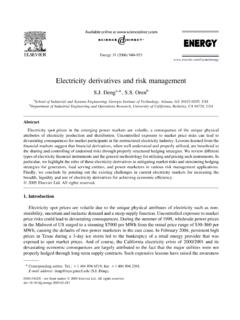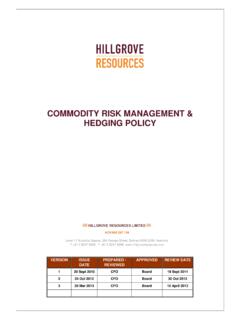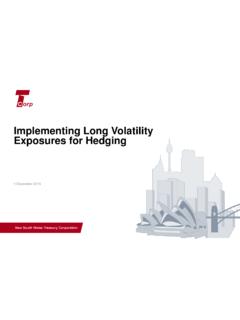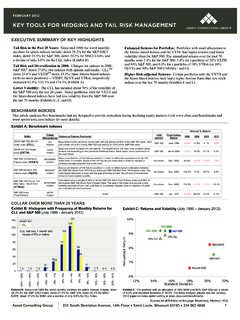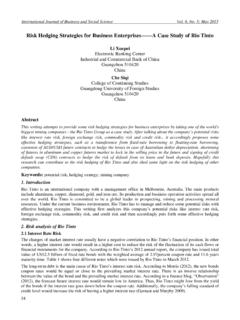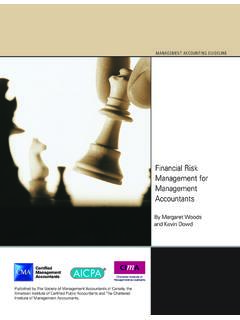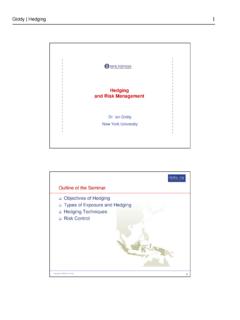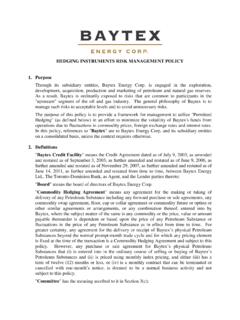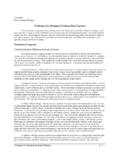Transcription of DEEP HEDGING - arXiv
1 1 deep HEDGINGHANS BUEHLER, LUKAS GONON, JOSEF TEICHMANN, AND BEN present a framework for HEDGING a portfolio of derivativesin the presence of market frictions such as transaction costs, market im-pact, liquidity constraints or risk limits using modern deep reinforcementmachine learning discuss how standard reinforcement learning methods can be appliedto non-linear reward structures, in our case convex risk measures. Asa general contribution to the use of deep learning for stochastic processes,we also show in section 4 that the set of constrained trading strategies usedby our algorithm is large enough to -approximate any optimal algorithm can be implemented efficiently even in high-dimensionalsituations using modern machine learning tools. Its structure does notdepend on specific market dynamics, and generalizes across HEDGING in-struments including the use of liquid derivatives. Its computational perfor-mance is largely invariant in the size of the portfolio as it depends mainlyon the number of HEDGING instruments illustrate our approach by showing the effect on HEDGING under trans-action costs in a synthetic market driven by the Heston model, where weoutperform the standard complete market words and phrases:reinforcement learning, approximate dynamic pro-gramming, machine learning, market frictions, transaction costs, HEDGING , riskmanagement, portfolio 2010 Classification: 91G60, problem of pricing and HEDGING portfolios of derivatives is crucial forpricing risk- management in the financial securities industry.
2 In idealized fric-tionless and complete market models, mathematical finance provides, withrisk neutral pricing and HEDGING , a tractable solution to this problem. Mostcommonly, in such models only the primary asset such as the equity and fewadditional factors are modeled. Arguably, the most successful such model forequity models is Dupire s Local Volatility [Dup94]. For risk management , wewill then compute greeks with respect not only to spot, but also to calibra-tion input parameters such as forward rates and implied volatilities - even ifsuch quantities are not actually state variables in the underlying model. Es-sentially, the models are used as a form of low dimensional interpolation of the1 Opinions expressed in this paper are those of the authors, and do not necessarily reflectthe view of JP : February 12, [ ] 8 Feb 20182 BUEHLER, GONON, TEICHMANN, AND WOOD HEDGING instruments. Under complete market assumptions, pricing and risk ofa portfolio of derivatives is real markets, though, trading in any instrument is subject to transactioncosts, permanent market impact and liquidity constraints.
3 Furthermore, anytrading desk is typically also limited by its capacity for risk and stress, or moregenerally capital. This requires traders to overlay the trading strategy impliedby the greeks computed from the complete-market model with their own ad-justments. It also means that pricing and risk are not linear, but dependent onthe overall book: a new trade which reduces the risk in a particular directioncan be priced more favourably. This is called having an axe .The prevalent use of the complete market models is due to a lack of effi-cient alternatives; even with the impressive progress made in the last years forexample around super- HEDGING , there are still few solutions which will scalewell over a large portfolio of instruments, and which do not depend on theunderlying market hedgingapproach addresses this deficiency. Essentially, we modelthe trading decisions in our HEDGING strategies as neural networks; theirfeaturesetsconsist not only of prices of our HEDGING instruments, but may also containadditional information such as trading signals, news analytics, or past hedgingdecisions quantitative information a human trader might use, in true machinelearning deep HEDGING strategies can be described and trained (optimized inclassical language) in a very efficient way, while the respective algorithms areentirely model-free and do not depend on the on the chosen market means we can include market frictions such as transaction costs, liquidityconstraints, bid/ask spreads, market impact etc, all potentially dependent onthe features of the modeling task now amounts to specifying a market scenario generator,a loss function, market frictions and trading instruments.
4 This approach lendsitself well to statistically driven market dynamics. That also means that we donot need to be able to compute greeks of individual derivatives with a classicderivative pricing model. In fact, we will need no such equivalent martingalemodel .Our approach is greek-free. Instead, we can focus our modeling efforton realistic market dynamics and the actual out-of-sample performance of ourhedging level optimizers then find reasonably good strategies to achieve goodout-of-sample HEDGING performance under the stated objective. In our exam-ples, we are using gradient descent Adam [KB15] mini-batch training for asemi-recurrent reinforcement learning illustrate our approach, we will build on ideas from [IAR09] and [FL00]and optimize HEDGING of a portfolio of derivatives underconvex risk be able to compare our results with classic complete market results, wechose in this article to drive the market with a Heston model. We re-iteratethat our algorithm is not dependent on the choice of the illustrate our algorithm, we investigate the following questions: deep HEDGING3 Section : How does neural network HEDGING (for different risk-pre-ferences) compare to the benchmark in a Heston model without trans-action costs?
5 Section : What is the effect of proportional transaction costs on theexponential utility indifference price? Section : Is the numerical method scalable to higher dimensions?Our analysis is based on out-of-sample calculate our HEDGING strategies numerically, we approximate them bydeep neural networks. State-of-the-art machine learning optimization tech-niques (see [IGC16]) are then used to train these networks, yielding a close-to-optimaldeep hedge. This is implemented our Heston model, trading is allowed in both stock and a variance experiments with proportional transaction costs show promising resultsand the approach is also feasible in a high-dimensional is a vast literature on HEDGING in marketmodels with frictions. We only highlight a few to demonstrate the complexcharacter of the problem. For example, [RS10] study a market in which tradinga security has a (temporary) impact on its price. The price process is mod-elled by a one-dimensional Black-Scholes model.
6 The optimal trading strategycan be obtained by solving a system of three coupled (non-linear) PDEs. In[PBV17] a more general tracking problem (covering the temporary price im-pact HEDGING problem) is carried out for a Bachelier model and a closed formsolution (involving conditional expectations of a time integral over the op-timal frictionless HEDGING strategy) is obtained for the strategy. [HMSC95]prove that in a Black-Scholes market with proportional transaction costs, thecheapest superhedging price for a European call option is the spot price ofthe underlying. Thus, the concept of super-replication is of little interest topractitioners in the one dimensional case. In higher dimensional cases it suffersfrom numerical is well known that deep feed forward networks satisfy universal approx-imation properties, see, , [Hor91]. To understand better why they are soefficient at approximating HEDGING strategies, we rely on the very recent andfascinating results of [HBP17], which can be stated as follows: they quantifythe minimum network connectivity needed to allow approximation ofallele-ments in pre-specified classes of functions to within a prescribed error, whichestablishes a universal link between the connectivity of the approximating net-work and the complexity of the function class that is approximated.
7 An ab-stract framework for transferring optimalM-term approximation results withrespect to arepresentation systemto optimalM-edge approximation resultsfor neural networks is established. These transfer results hold for dictionariesthat arerepresentable by neural networksand it is also shown in [HBP17] thata wide class of representation systems, coinedaffine systems, and includingas special cases wavelets, ridgelets, curvelets, shearlets, -shearlets, and moregenerally, -molecules, as well as tensor-products thereof, are re-presentableby neural networks. These results suggest an explanation for the unreason-able effectiveness of neural networks: they effectively combine the optimal4 BUEHLER, GONON, TEICHMANN, AND WOOD approximation properties of all affine systems taken together. In our applica-tion of deep HEDGING strategies this means: understanding the relevant inputfactors for which the optimal HEDGING strategy can be written are several related applications of reinforcement learning in financewhich have similar challenges, of which we want to highlight two relatedstreams: the first is the application to classic portfolio optimization, with-out options and under the assumption that market prices are available forall HEDGING instruments.
8 As in our setup, this problem requires the use ofnon-linear objective functions, for example [MW97] or [ZJL17]. The sec-ond promising application of reinforcement learning is in algorithmic trading,where several authors have shown promising results, [DZL09] and [Lu17]to give but two novelty in this article is that we cover derivatives in the first place, andin particular over-the-counter derivatives which do not have an observablemarket price. For example, [Hal17] covers HEDGING using Q-learning with onlythe stock price under Black&Scholes assumptions and without puts our article firmly in the realm of pricing and risk managing a con-tingent claims in incomplete markets with friction cost. A general introductioninto quantitative finance with a focus on such markets is [FS16]. rest of the article is structured as follows. In Sections 2 and3 we provide the theoretical framework for pricing and HEDGING using convexrisk measures in discrete-time markets with frictions.
9 Section 4 outlines theparametrization of appropriate HEDGING strategies by neural nets and providestheoretical arguments why it works. In Section 5 several numerical experimentsare performed demonstrating the surprising feasibility and accuracy of : Discrete time-market with FrictionsConsider a discrete-time financial market with finite time horizonTandtrading dates 0 =t0< t1< .. < tn=T. Fix a finite1probability space ={ 1,.., N}and a probability measurePsuch thatP[{ i}]>0 for alli. Wedefine the set of all real-valued random variables over asX:={X: R}.We denote byIkwith values inRrany new market information available attimetk, including market costs and mid-prices of liquid instruments typicallyquoted in auxiliary terms such as implied volatilities , news, balance sheetinformation, any trading signals, risk limits etc. The processI= (Ik)k=0,..,ngenerates the filtrationF= (Fk)k=0,..,n, all informationavailable up totk. Note that eachFk-measurable random variable can bewritten as a function ofI0.
10 ,Ik; this is therefore the richest available featureset for any decision taken assumption that is finite is only essential for the numerical solution of the optimalhedging problem (from Section onwards). Alternatively, we could start with arbitrary and discretize it for the numerical solution. If we imposed appropriate integrability conditionson all assets and contingent claims, then the results prior to section would remain validfor general . deep HEDGING5 The market containsdhedging instruments with mid-prices given by anRd-valuedF-adapted stochastic processS= (Sk)k=0,..,n. We donotrequirethat there is an equivalent martingale measure under whichSis a stress that our HEDGING instruments are not simply primary assets such asequities, but also secondary assets such as liquid options on the former. Someof those HEDGING instruments are therefore not tradable before a future pointin time ( an option only listed in 3M with then time-to-maturity of 6M).Such liquidity restrictions are modeled alongside trading cost portfolio of derivatives which represents our liabilities is anFTmea-surable random variableZ.
![arXiv:0706.3639v1 [cs.AI] 25 Jun 2007](/cache/preview/4/1/3/9/3/1/4/b/thumb-4139314b93ef86b7b4c2d05ebcc88e46.jpg)

![arXiv:1301.3781v3 [cs.CL] 7 Sep 2013](/cache/preview/4/d/5/0/4/3/4/0/thumb-4d504340120163c0bdf3f4678d8d217f.jpg)
![@google.com arXiv:1609.03499v2 [cs.SD] 19 Sep 2016](/cache/preview/c/3/4/9/4/6/9/b/thumb-c349469b499107d21e221f2ac908f8b2.jpg)







